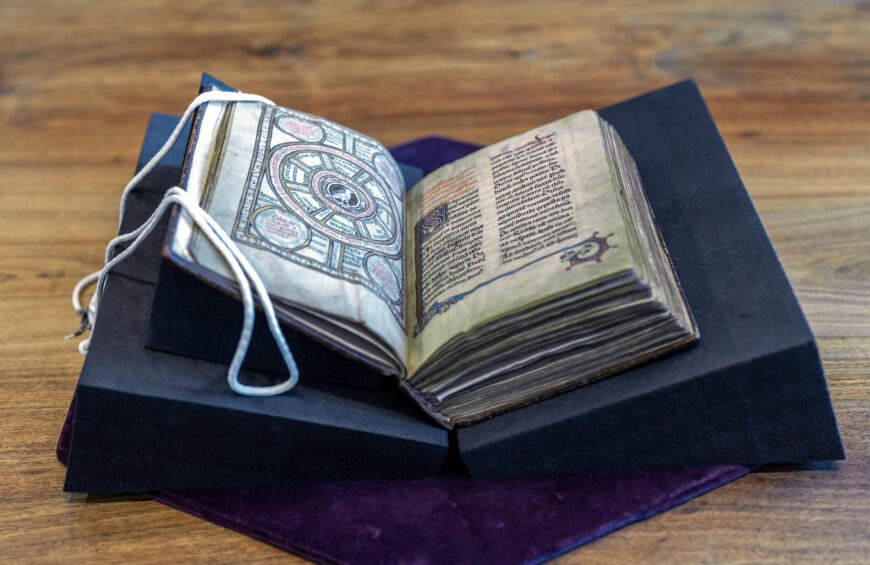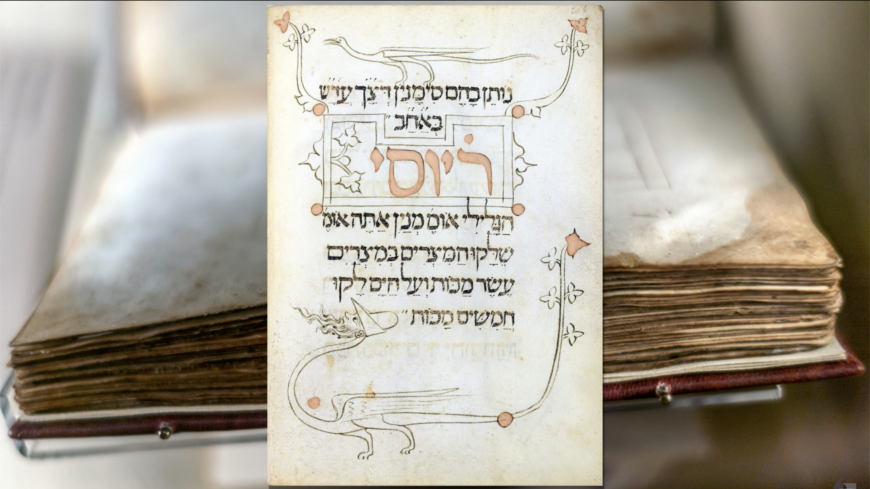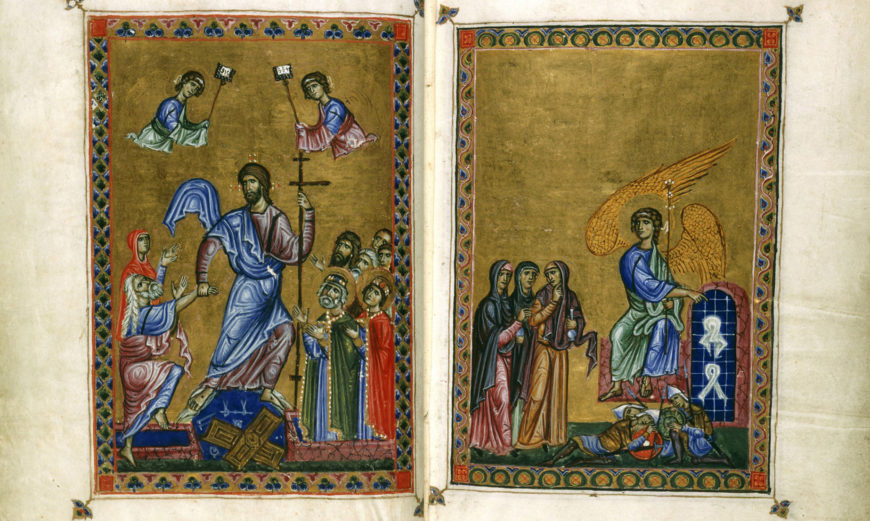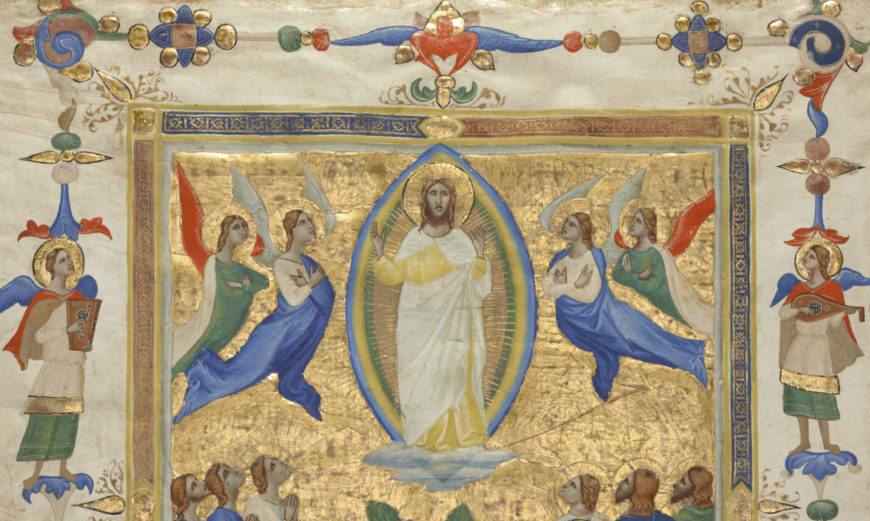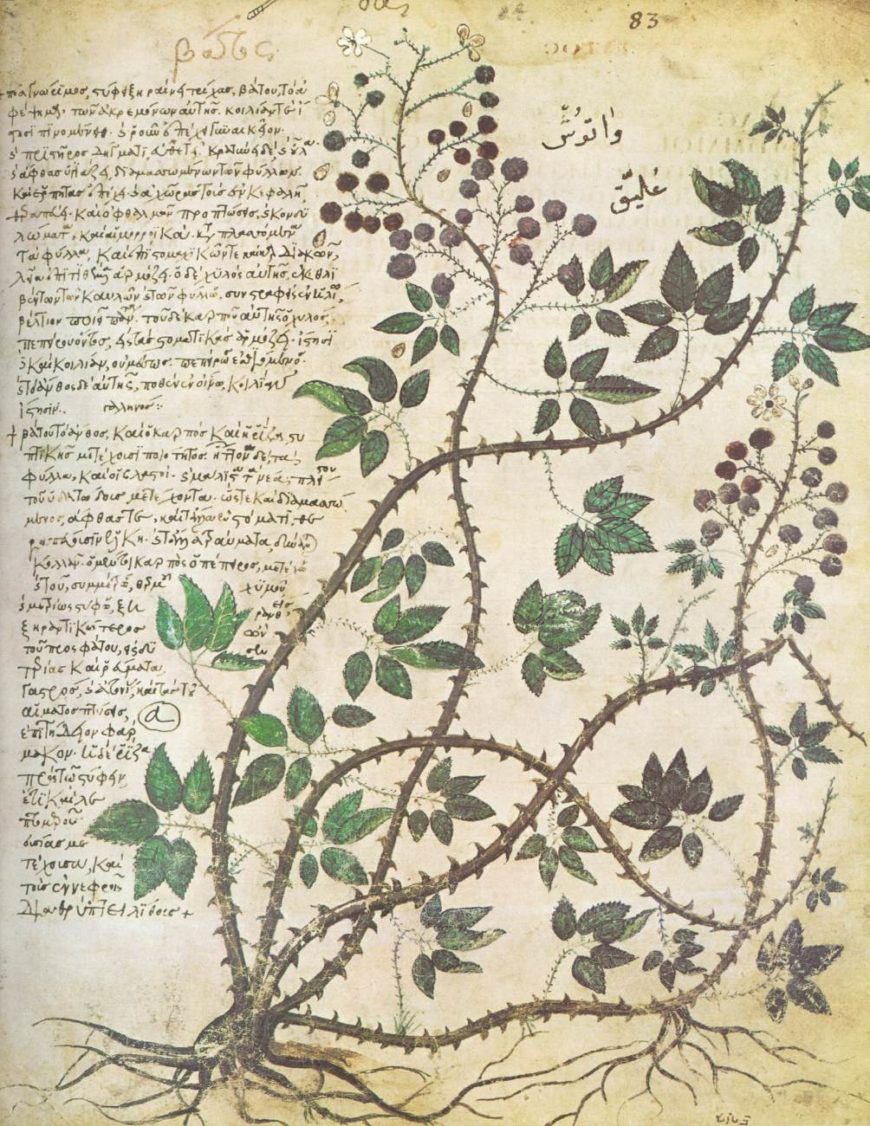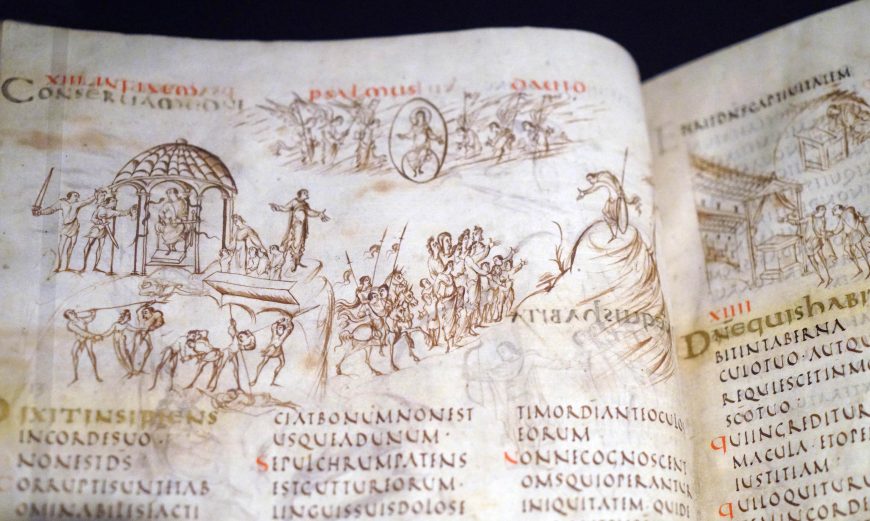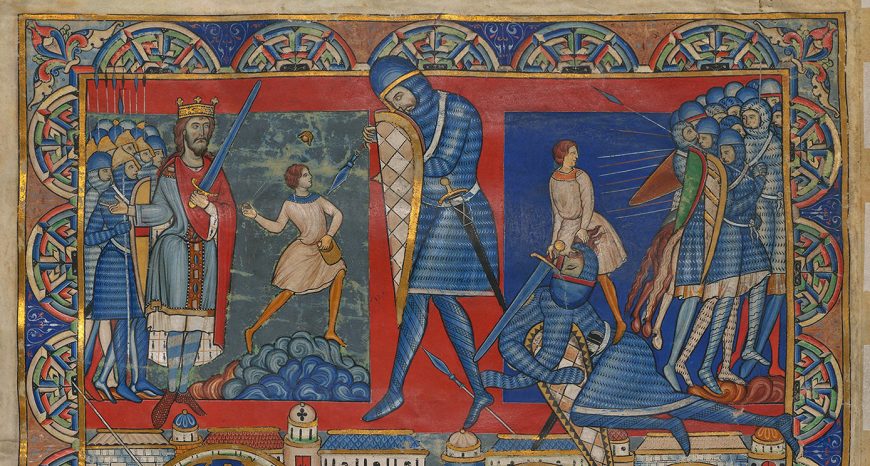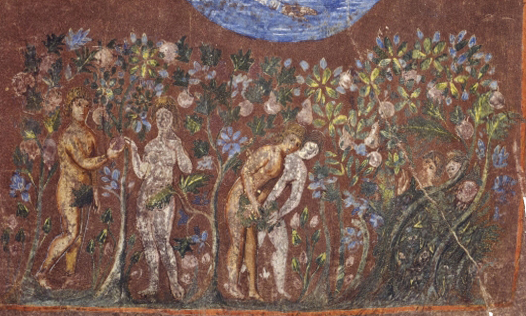Boethius, De institutione arithmetica, c. 1100 (The National Library of the Netherlands, The Hague, MS 78 E 59)
Special thanks to Ed van der Vlist, Curator of Medieval Manuscripts, Koninklijke Bibliotheek, National Library of the Netherlands.
[0:00] [music]
Dr. Erik Kwakkel: [0:04] We’re in the Royal Library, the National Library of the Netherlands, in The Hague. We’re looking at an 11th century manuscript, a mathematical text, which was very popular in education at the time. Most books made for education in this early period, particularly, are not very fancy.
Dr. Beth Harris: [0:20] This is 1,000 years old.
Dr. Kwakkel: [0:22] Yes.
Dr. Harris: [0:23] Yet it looks so recognizable.
Dr. Kwakkel: [0:24] The book now is still very medieval. If you look at dimensions, if the height is 1, the width will be .7 and that’s exactly what we now have, at least in Europe, because American paper is a little bit different.
Dr. Harris: [0:33] The people of the Middle Ages found the perfect form factor.
Dr. Kwakkel: [0:37] There are some variations. Some books are more narrow, other ones are broader.
Dr. Harris: [0:41] This wasn’t printed, someone wrote this. I can feel that when I look at the ink.
Dr. Kwakkel: [0:46] It’s what we call a manuscript, from Latin “manuscripta” — “written by hand.” Here you see that all individual letters are written. Even each letter is written in different strokes. You couldn’t really write one letter at the same time, you needed to break it up into little pieces.
Dr. Harris: [1:01] The person who did this was a professional. This was a hard job.
Dr. Kwakkel: [1:04] You could only write if you were a professional. If you had been trained to write, not just in this type of script, and this is what we call a “book script,” because it has a formal approach to it. This kind of script you can only do if you not only had a lot of training but also a lot of experience.
[1:19] If you open this book for the first time, there’s a number of things that you see if you’re only used to looking at modern books. One is, there’s no title page.
Dr. Harris: [1:25] There’s no publisher with a date.
Dr. Kwakkel: [1:27] There’s nothing, no date, no made in this city, etc. It’s not even saying what the text is. The idea is, you know what it is, because when you read the first lines, it’s Boethius, and it’s that particular text of Boethius. Sometimes, later you’ll have what we call “rubrics,” which is a little title written in red on top, which evolves into the title page that we now have.
[1:48] This is not paper. This was once a cow or a calf running through the field, and it’s been turned into a book.
Dr. Harris: [1:54] Someone took the skin of the animal and stretched it.
Dr. Kwakkel: [1:58] Yeah, you put it on a frame of wood, after you’ve put it in a substance of lye and other things.
Dr. Harris: [2:04] That clean off the hair and the fur, and the…
Dr. Kwakkel: [2:06] Most of the hair, and then you still have to clean off the remaining hair and the bits of pieces of flesh.
Dr. Harris: [2:10] I would imagine it would take months to make.
Dr. Kwakkel: [2:12] It will take a few weeks to make a batch, but then when you buy it as a scribe, or as a monastery, you still need to prepare it for writing.
Dr. Harris: [2:20] There were different grades of parchment.
Dr. Kwakkel: [2:22] Yes.
Dr. Harris: [2:22] Looking at this, can you tell what grade of parchment it is?
Dr. Kwakkel: [2:25] This is a book made for education, and what’s remarkable in books for education is that it’s often not the best quality of parchment. It’s a little bit comparable to textbooks that we have nowadays. You go for the cheap one, if there is one.
Dr. Harris: [2:37] That makes sense, you just need the information that’s in it. You don’t need a fancy book.
Dr. Kwakkel: [2:41] A beautiful book in the church, a Gospel book that was displayed on the altar, would usually be written in a very nice script and in the best parchment with illumination. Very few books were illuminated. It’s exceptional to have a book with gold and shiny colors on the page.
Dr. Harris: [2:55] Then the parchment was folded, put together into groups, and then bound together.
Dr. Kwakkel: [3:01] They’re called “quires” or “gatherings.” We can see that usually about four, what we call “double leaves” or “bifolia,” so, long leaves folded once. Four of those folded leaves would produce one quire.
[3:14] A book like this will probably hold about four or five of them but if you have a longer text, like the Bible, it may have 20 or 30 quires. You would put them together as a scribe. This is a nice example of…you can see the skin of the animal. You can even see a little bit of hair.
[3:27] This was not very good parchment to begin with, because it’s yellowish, and there’s stains over it. If you look at it, you can see that it’s white, yellow, white, yellow, white, yellow, and so this animal was not so good to begin with. This part here is the edge of the beast. It should actually have been trimmed.
Dr. Harris: [3:42] It was very valuable, so you used as much as possible.
Dr. Kwakkel: [3:45] It’s for education, so it’s no problem if it looks a bit scruffy.
Dr. Harris: [3:47] I can imagine a scribe dipping a quill pen, a feather pen, into ink, and needing to be very careful about making blotches of ink. One book must have taken months to make.
Dr. Kwakkel: [3:59] It’s extremely slow going to produce this material even, to make it flat and smooth so you can write on it, and also producing letters that consist of various bits and pieces. If you have an M, for example, you can’t write it down like we do, because you can’t go up with your pen.
[4:15] You need to do stroke, stroke, stroke, down, down, down, for an M. At the heart of making those quires, the pages, is a number of activities. One is to prick the margins…
Dr. Harris: [4:26] And then you put a ruler down.
Dr. Kwakkel: [4:27] then you put a ruler over it, and then you draw your lines. In this case — and this is why we can also in part see that it’s an 11th-century manuscript — it’s not color that makes the ruling, it’s pressure. It’s what we call “blind ruling,” which means it’s blind in a sense because you can hardly tell that it’s there.
[4:43] It means a sharp device was used to press down on the parchment, sometimes even the whole quire at the same time. You push very hard on a closed quire, and then it travels throughout the pages. If you are beyond the 11th century, in the 1130s, 1140s, there’s a new technique, which is ruling with plummet, so pencil, a big piece of lead, and then you have gray lines.
Dr. Harris: [5:04] You said this was made in an educational context.
Dr. Kwakkel: [5:07] This is the time where universities didn’t yet exist, but people in the monastery needed to be trained in reading and writing. They needed to have grammar, rhetoric, Latin. Here we have a scribe that is writing his book and may have been by himself.
[5:20] Sometimes, scribes worked together either in a scriptorium, or in their cell, or two people working in different cells, a division of labor that you still see nowadays.
Dr. Harris: [5:29] I noticed text in the margins, too.
Dr. Kwakkel: [5:32] On this page you have a main scribe in brown ink. You have either the same scribe or somebody else writing a “rubric” in red ink, from Latin for red, and you have likely a reader in the margin writing. There’s a little symbol here, an L with a bar through it, which is Latin for “vel.” It’s an abbreviated word which means “alternatively.”
[5:53] Somebody compared it likely to another text dealing with the same subject, and came up with a different reading of this particular passage.
Dr. Harris: [6:00] Why the red?
Dr. Kwakkel: [6:02] It catches your eye. When you look at this page, it jumps out at you. The function is to say, “Go with your eyes here, because something new starts.”
Dr. Harris: [6:08] The same thing as the initial letter.
Dr. Kwakkel: [6:10] Also, sometimes helps you, as a reader, to find what you need. Imagine your scribe sitting in his cell or a scriptorium, copying a book. He will have what we call an “exemplar” in front of him.
Dr. Harris: [6:22] The book that he’s copying.
Dr. Kwakkel: [6:23] Copying from. The main activity here, that is the result of somebody looking at a book in front of him over and over again, and copying the half a line at a time onto this until the text is complete.
[6:33] [music]


